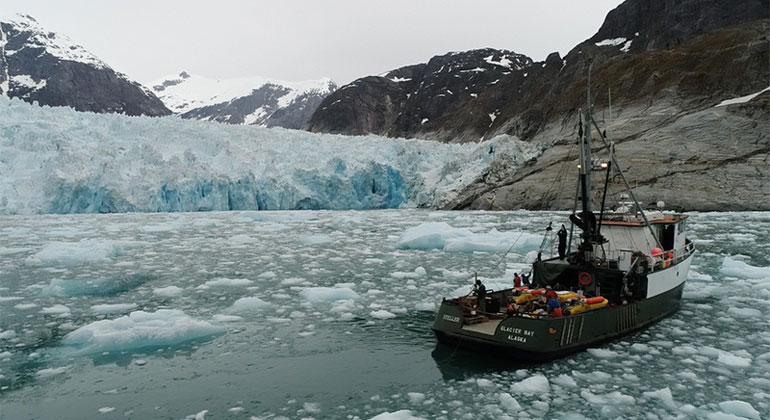New data from UO-led study may change glacial melt predictions
Working in ice-clogged seawater in small chartered boats, a University of Oregon-led research team successfully used sonar to scan Alaska’s LeConte Glacier in the first field tests of a long-used theory on melting that occurs under glaciers. The theory, used in modeling to project climate-driven sea level rise, was shot down in its first real-world test and may need to be revised.
“What we found at this one location matters because many simulations of sea level rise and of iceberg melt all rely on this theory,” said the study’s lead Dave Sutherland, an oceanographer in the UO’s Department of Earth Sciences. “So our findings throw this theory into question.”
Reporting in the July 26 issue of the journal Science, the team concluded that tidewater glaciers — those that empty from land valleys into ocean water — are potentially melting at two orders of magnitude, or some 100 times, faster than predicted.
In the National Science Foundation-funded research, Sutherland’s team worked from two chartered vessels and used autonomous kayaks and drones while deploying a direct approach to measure and analyze the glacial melt rates relative to ocean conditions.
Most previous research on underwater glacial melting relied on theoretical modeling of conditions near glaciers and then applying theory to predict melt rates.
“This theory is used widely in our field,” said study co-author Rebecca H. Jackson, an oceanographer at Rutgers University who was a postdoctoral researcher at Oregon State University during the project. “It’s used in glacier models to study questions like how will the glacier respond if the ocean warms by 1 or 2 degrees?”
There are two main categories of glacial melt: discharge-driven and ambient melt on large floating ice shelves, such as in most of Antarctica, and those that end with near-vertical upright ice faces, which are common around Greenland and Alaska.
Subglacial discharge occurs when large volumes, or plumes, of buoyant meltwater are released below the glacier. The plume combines with surrounding water, picking up speed and volume as it rises swiftly against the glacial face steadily eroding the glacier face and undercutting the glacier before diffusing into the surrounding water.
Time-lapse photography done over eight hours from a camp located on a ridge above the LeConte Glacier in Alaska captures the underwater discharge plume flowing away from the glacier. Also visible are icebergs calving into the water, the marine vessel Steller and an autonomous kayak, from which measurements were taken of of the discharge plume. (Video by study co-author Jason Amundson of the University of Alaska Southeast)
Direct measurements at ocean-ice interfaces have been made on Antarctic glacial shelves by boring through the ice down to the water underneath. However, with vertical-face underwater glaciers, those techniques are logistically not possible.
“We don’t have that platform to be able to access the ice in this case,” said Sutherland, who heads the UO’s Oceans and Ice Lab. “These icebergs are always calving and moving very rapidly, you don’t want to take a boat up there.”
Previous studies of ice-ocean interactions have mostly focused on the discharge plumes, which typically affect only a narrow area of the glacier face, while ambient melt instead covers the rest of the glacier face, he said. Predictions have estimated ambient melt to be 10 to 100 times less than the discharge melt, and, as such, it is often disregarded as insignificant, he said.
To test the theoretical models in the field, the research team used a multibeam sonar to scan the glacier’s ocean-ice interface six times in August 2016 and five times in May 2017. Sonar allowed the team to image and profile large swaths of the underwater ice. Also gathered were data on temperature, salinity and velocity of water downstream from the glacier, which allowed the researchers to estimate the meltwater flow.
Underwater melt rates were found to be high across the glacier’s face over both of the seasons surveyed, and the melt rate increases from spring to summer.
“We measured both the ocean properties in front of the glacier and the melt rates, and we found that they are not related in the way we expected,” Jackson said. “These two sets of measurements show that melt rates are significantly, sometimes up to a factor of 100, higher than existing theory would predict.”
While the study focused on one marine-terminating glacier, Jackson said, the new approach should be useful to any researchers who are studying melt rates at other glaciers. That would help to improve projections of global sea level rise, she added.
“Future sea level rise is primarily determined by how much ice is stored in these ice sheets,” Sutherland said. “We are focusing on the ocean-ice interfaces, because that’s where the extra melt and ice is coming from that controls how fast ice is lost. To improve the modeling, we have to know more about where melting occurs and the feedbacks involved.”
The research team also included members from the University of Alaska Southeast, Juneau and Fairbanks; University of Texas at Austin; University of North Carolina; and Oregon State University.
Source
Oregon State University 2019 | By Carolyn Levinn and Jim Barlow, University Communications








